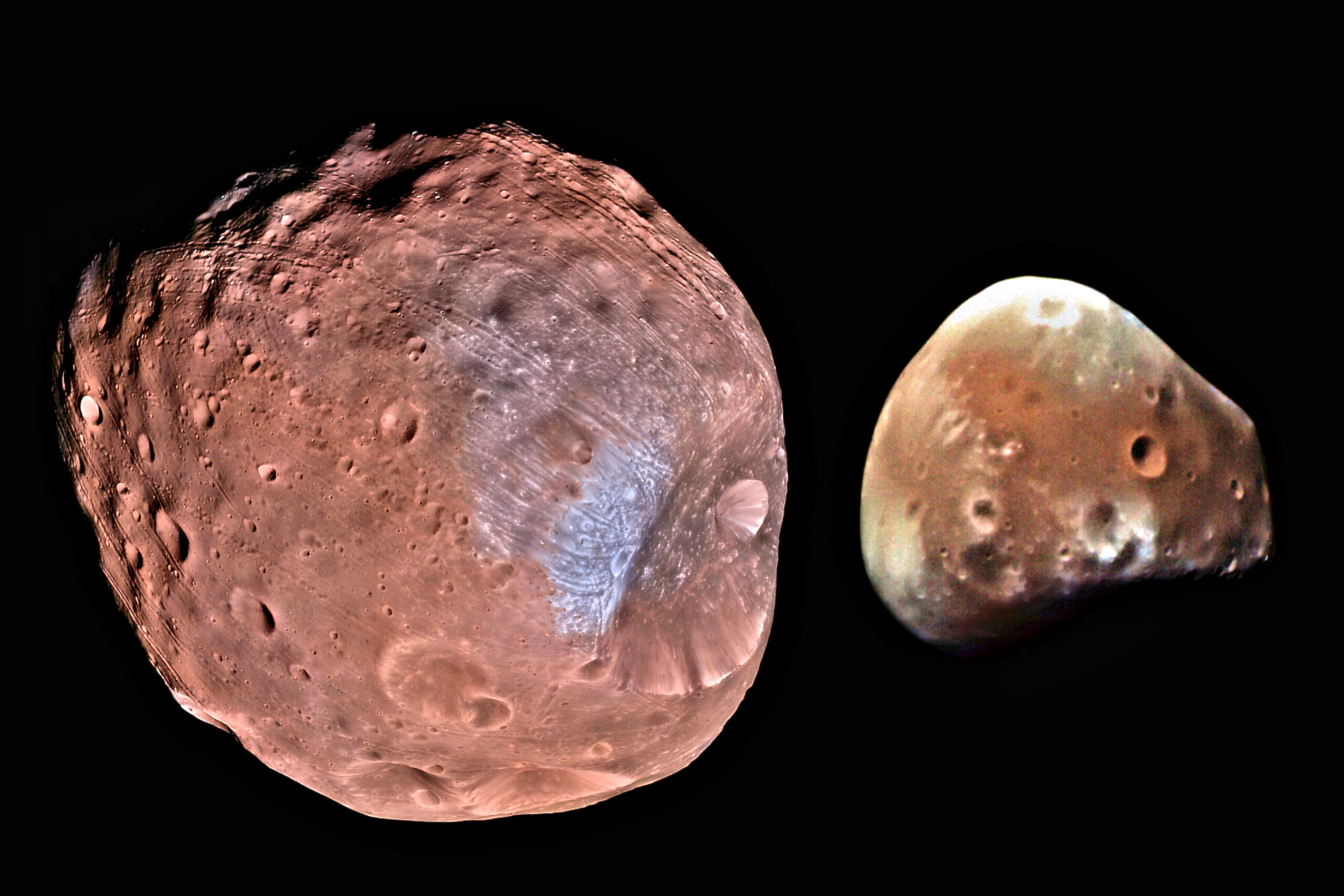Phobos and Deimos are the two moons of Mars—the first discovered by Asaph Hall in 1877. Unlike any other moons in the solar system, Phobos and Deimos are unique in that they are much larger than they are wide, with an unusual elongated shape resulting from intense tidal forces during its formation. This moon strangeness doesn’t stop there, however; both Phobos and Deimos move closer to their parent planet at very high speeds—Deimos whips around Mars once every 7 hours while Phobos orbits it in less than eight hours.
Introducing Mars’ Moons
Discovered by Asaph Hall on August 12, 1877, Mars’ two moons—Phobos and Deimos—stand out among their counterparts. While they are both tiny when compared to Earth’s moon (about 20 km in diameter), they also orbit much closer to Mars than our moon orbits us. They also both have orbital periods of less than seven hours, meaning a day on either moon would last just over an hour. The closest approach distance between Mars and its moons is about 4000 km. It is thought that these two small bodies were formed after a large impact created debris that eventually coalesced into Phobos and Deimos. Both moons are made up almost entirely of carbonaceous material, which makes them very dark; thus, they reflect only 7% of light that hits them. Phobos and Deimos are named after characters from Greek mythology: Phobos was one of Ares’ sons who personified fear while his brother Deimos represented terror. Both were companions to Ares during his war with Zeus. Due to tidal forces caused by Mars’ gravity, Phobos and Deimos slowly spiral inward toward Mars until one of them will be destroyed upon colliding with it. Scientists think that within 30 million years or so, Phobos will be torn apart at some point in time due to tidal forces exerted on it by Mars.
Phobos
The most visible feature on Phobos is a massive crater that dominates its southern hemisphere. The impact that created Stickney, named for American astronomer Asaph Hall who discovered Phobos and its sibling moon Deimos in 1877, formed not only one of Mars’ largest craters but also created a gigantic canyon system now stretching for more than 1000 kilometers (620 miles). Stickney is so large it nearly spans the entire width of Phobos. If you were standing at its center, you would see just over half of Phobos’ surface. This is because both moons are potato-shaped: flat at their poles and wider near their equators. With an average diameter of 25 kilometers (16 miles), Phobos is smaller than Earth’s own Moon—but it’s still big enough to be classified as a dwarf planet like Pluto or Ceres. However, unlike those distant objects, Phobos orbits much closer to its host planet. At 6,000 kilometers (3,700 miles) above Mars’ surface it circles once every 7 hours; at times it can even appear twice as wide as our Moon appears from Earth.
Deimos
The closest moon to Mars—Deimos—is also one of its strangest. Unlike Earth’s familiar and beloved Luna, Deimos is a small, irregularly shaped body that orbits close to Mars. It has a diameter of just seven miles (11 kilometers) at its widest point, making it only about half as wide as our own Moon. And unlike most moons, which are spherical due to their distance from their planet, Deimos is elongated because it travels so close to Mars. As a result, it looks more like an asteroid than anything else in our solar system. Its orbit takes just over 30 hours to complete, but since it takes Mars less than 24 hours to spin once on its axis, Deimos rises in the west and sets in the east every Martian day. On average, Deimos sits about 5,800 miles (9,300 km) above Mars’ surface. But sometimes it comes within 3,700 miles (6,000 km), which makes for some pretty spectacular views through a telescope! That said, NASA does not recommend looking directly at Deimos with your naked eye; you should use binoculars or a low-magnification telescope when you want to see it up close. You can even see Deimos during some evenings with a clear view of the night sky; its orbit means that during some months it will be visible during dusk and dawn, rising after sunset and setting before sunrise.
Unknown Facts About Mars’ Moons
Mars’ moons are often left out of conversations about our solar system. They don’t get as much attention as other moons, such as Jupiter’s Europa or Neptune’s Triton, but they still offer some great lessons about space exploration. For example, Mars’ outermost moon, Phobos, is only 6 miles across—the size of a large city like Boston or San Francisco—yet it orbits closer to its planet than any other known moon in our solar system. In fact, if you were standing on its surface, you would experience gravity that’s three times stronger than what we feel on Earth! This means that Phobos has one of the highest density ratios in our solar system: It’s made up almost entirely of rock and iron. In comparison, Earth has a density ratio of 5.5 grams per cubic centimeter; by comparison, Phobos has an estimated density ratio of 14 grams per cubic centimeter!
![]()
